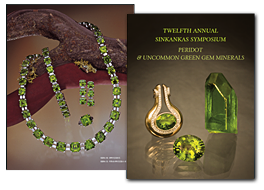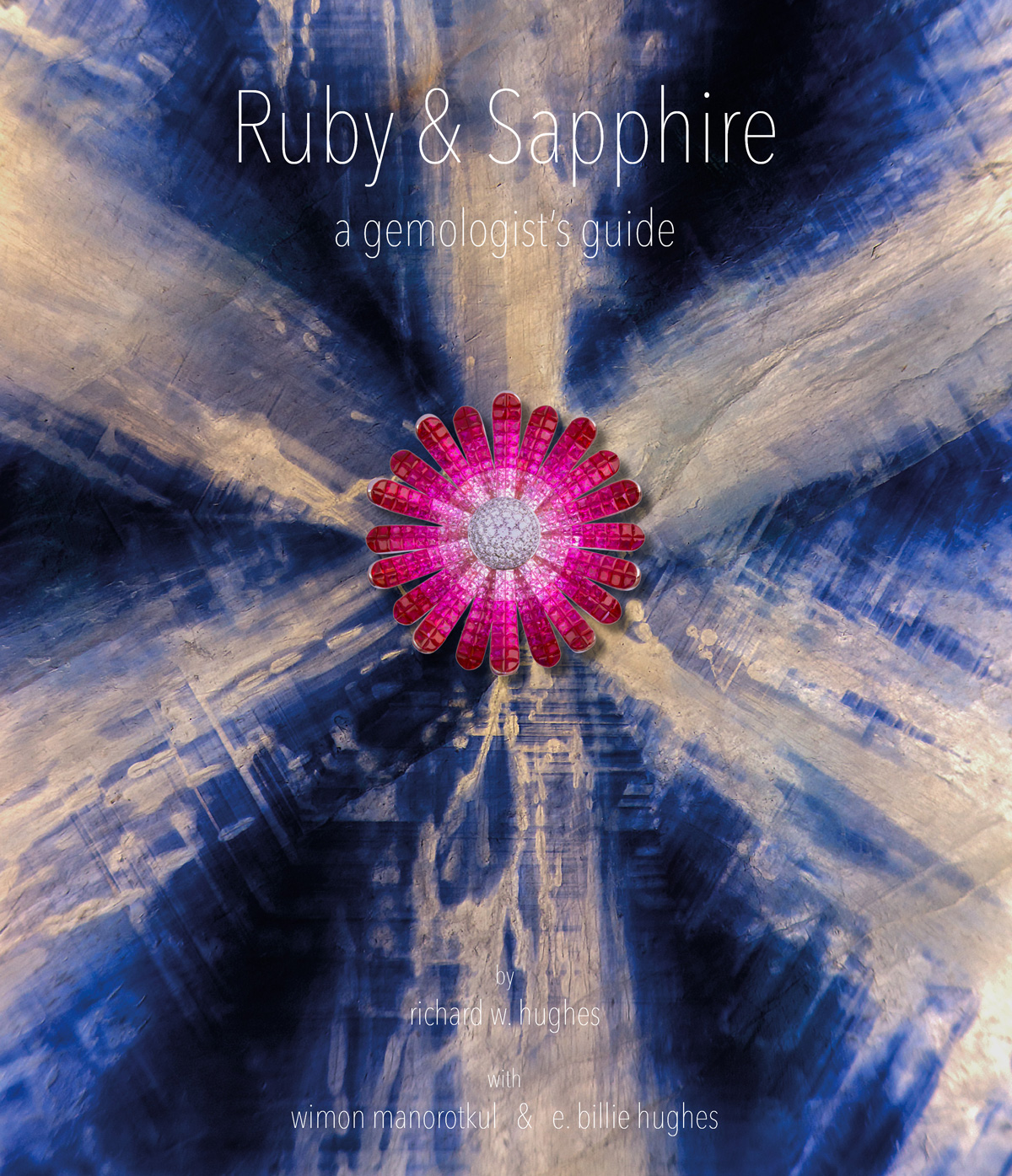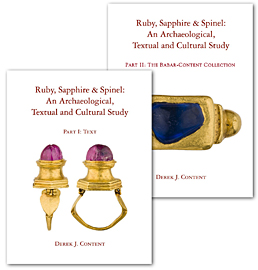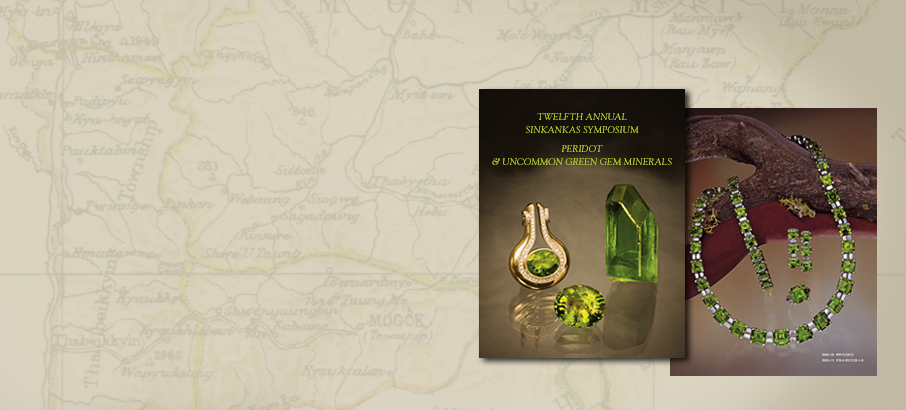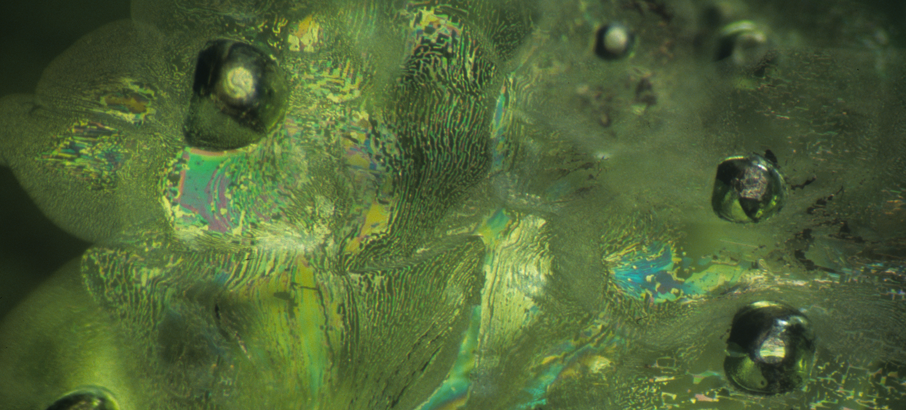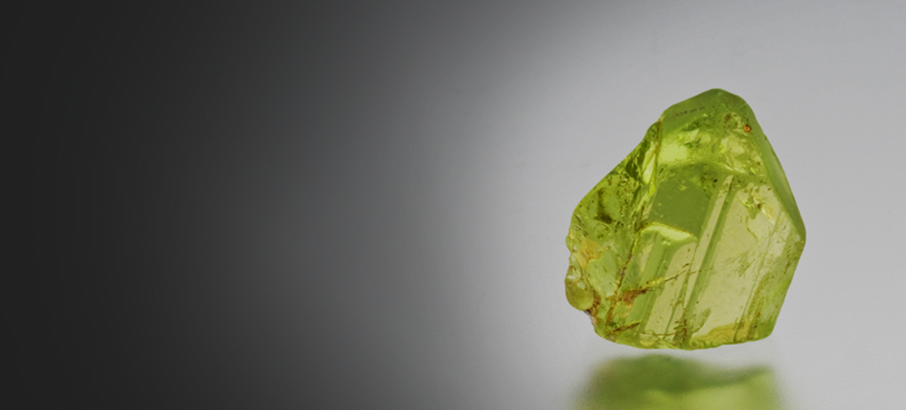TWELFTH ANNUAL SINKANKAS SYMPOSIUM – SPEAKERS *
Recognized specialists in fields ranging from geology and mineralogy to history, treatment, cutting, collecting and selling will make presentations on Peridot and Uncommon Green Gem Minerals.
Dr. James A. Harrell, keynote speaker – Discovery of the Red Sea source of Topazos (ancient gem peridot) on Zabargad Island, Egypt – abstract »
Egypt's Red Sea island of Zabargad, also called St. John's Island, is arguably the world's most famous source of gem olivine, or peridot. Both the island and its eponymous gemstone were called "topazos" by ancient naturalists. Although much has been written about Zabargad's unusual geology and modern mine workings, an ancient peridot mine had not been verified until recently. A geo-archaeological expedition to the island in 2010 confirmed the existence of ancient mine workings and associated ruins of buildings and a water well. The findings from this expedition are discussed in relation to ancient texts written on the subject and the relationship between Zabargad and Berenike, the Ptolemaic-Roman port city on the Egyptian mainland opposite the island and a major emporium for the maritime trade with eastern Africa, the Persian Gulf and India. Peridot was imported via this port-of-entry into the Graeco-Roman world, where it was used primarily for ring stones. A survey of extant examples of these beautifully carved intaglios will be presented.
Dr. Skip Simmons – Mineralogy and crystallography of olivine – abstract »
The olivine group is a magnesium-iron silicate with the chemical composition (Mg, Fe)2 SiO4 and occurs as a complete solid solution series between the Mg-rich end member forsterite, Mg2SiO4, and the Fe-rich end member fayalite, Fe2SiO4. Olivine is orthorhombic, with crystals of gem peridot typically forming flattened, tabular to box-shaped crystals. More commonly, olivine is found as rounded alluvial grains in beach sands weathering from basalt and as granular masses of anhedral crystals in dunite xenoliths in basalt. Structurally, it is a nesosilicate with individual SiO4 tetrahedra linked by (Mg, Fe) atoms, each with six nearest neighbors. The physical properties, chemical composition and crystal structure of olivine will be examined in this presentation.
Dr. James E. Shigley – Olivine geology – abstract »
Olivine is one of the most abundant natural minerals. It is an important constituent of mafic and ultramafic igneous rocks, and certain metamorphic rocks such as marbles. Sources of material suitable for faceting are limited, with the most important current ones being located in China, Myanmar, Pakistan and the United States.
Dr. Raquel Alonso-Perez – How green was my Sapat Valley: Peridot of Pakistan – abstract »
Pakistan has been known since ancient times for its gem quality crystals of aquamarine, tourmaline, topaz, garnet, ruby, and so on. However, peridot, the gem variety of olivine, was only recently discovered in the Sapat Valley of Pakistan in 1994. Nowadays, the Sapat Valley is the source of one of the most desired peridots in the jewelry business because of its large size, quantity and fine gem quality.
The Sapat Peridotite, located directly above the collision between the Indian Plate and the Kohistan Island Arc, consists of a metasomatosized ultramafic body with gem-olivine-magnetite-calcite-chlorite crosscutting veins. These veins provide a window into some of the geochemical characteristics of the mantle wedge in arc settings and therefore into the origin of gem-quality peridot formation.
Dr. George Harlow – Peridot from Pyaung-gaung, Mogok Tract, Myanmar: Similarities to Sapat and Zabargad deposits – abstract »
Peridot is the gem variety of olivine, with grass green color, moderately-good gem properties and a long history of use. Large stones are famous from the island of Zabargad, Egypt and the Mogok Stone Tract of Myanmar. Curiosity about the origin of this gem from Myanmar and its relationship to that of Zabargad and another important occurrence at Sapat, Kohistan, Pakistan was a part of the driving force for a recent expedition by geologists at the American Museum of Natural History to visit the Mogok Tract. Preliminary results from a study of the peridot source and collected samples confirms a hypothesis that hydrous (rich in H2O) fluid was critical in the formation of large gem peridots, crystallized in fractures of mantle rock (peridotite) probably during exhumation along geologic faults present in the Mogok Tract.
Nathan Renfro – Cutting peridot and the exploration of its inclusions – abstract »
Lapidary techniques will be explored in addition to optimization of optical performance of peridot. A variety of inclusions seen in peridot from several localities will also be shown.
Lisbet Thoresen – Chromian chalcedony: a gem from history's lost and found – abstract »
The rare emerald green-colored microcrystalline quartz variety known as "chrome" chalcedony or "Mtorolite" came to the attention of mineralogists with its first modern discovery near Mtoroshanga, Zimbabwe in 1956. Several other sources have been identified in recent decades; however, awareness of this rare gem predates its modern discovery by 2000 years. It was probably one of the twelve different varieties of “smaragdus” described by the Roman naturalist Pliny the Elder (d. AD 79). This "poor man's emerald" circulated widely throughout the Roman empire between the 1st century BC and the early 3rd century AD, with thousands of ringstones found in archaeological contexts as far away as Roman Gaul (France) and Britain.
Robert Weldon – Magnificent jewels of the Cheapside Hoard – abstract »
An astonishing treasure trove of jewels was uncovered by a demolitions workman in the Cheapside neighborhood of London, in 1912. Of the 500 plus items that comprise the hoard, numerous loose gems including peridot, garnets, diamonds, and emeralds were found. They, as well as hundreds of pieces of jewelry and other items, offer scholars a unique glimpse of Renaissance jewelry. Much is also revealed about the global trade in gemstones – such sourcing for peridot on the Egyptian island of Zabargad, or the importation of emeralds from Muzo, Colombia, during the late 1500s and 1600s.
The Cheapside Hoard, as this treasure is known, is on display in its entirety at the Museum of London until late April, 2014. GIA's principal gem photographer, Robert Weldon was offered an unique opportunity to see and photograph several of the treasure's most significant pieces. Join Robert as he describes the treasure and his photographic journey with them.
Dr. James E. Shigley – Green gem materials – abstract »
Besides olivine, a variety of other natural green materials have been manufactured on occasion for jewelry use. In addition to emerald, jade, garnet and tourmaline, other materials are of much less common occurrence, or are not often seen in fashioned form as gems, but nonetheless can display a very attractive appearance.
William Larson – Green with envy: Gem minerals from the collection of William F. Larson – abstract »
A photographic odyssey of fine crystals and cut gems from worldwide localities featuring peridot and a panoply of uncommon green gems of beguiling beauty ranging from A (actinolite) to Z (zircon).
Dr. George Rossman – Causes of color in the green minerals – abstract »
The green color of peridot arises from its iron content as do the colors of some other gems. However, many of the more desirable green gems such as emerald, demantoid, tsavorite, and chrome tourmaline owe their color to vanadium or chromium. But chromium is also resposible for the red color of both ruby and spinel. The reason for this ostensible paradox is discussed along with the causes of color in other green gem minerals.
* speakers or topics subject to change without notice
TWELFTH ANNUAL SINKANKAS SYMPOSIUM – SPEAKER BIOGRAPHIES
Dr. Raquel Alonso-Perez – bio »
Raquel Alonso-Perez joined the Harvard Mineralogical and Geological Museum in March 2011 as an assistant curator and moved to her present role as Curator in November 2013. Raquel received her B.S. in geology from the University of Granada, Spain and remained to receive a master in petrology and structural geology from Granada and from the National University of San Luis, Argentina on the contact metamorphism and deformation of the Tamboreo-Tonalite in the Sierra de San Luis of central Argentina. She received her Ph.D. in 2007 from the Swiss Federal Institute of Technology (ETH) in Zurich for her thesis entitled: "The role of garnet in the evolution of hydrous, calc-alkaline magmas" an experimental study at 0.8 – 1.5 GPa. Her main research interests are continental crust formation processes and recently the geochemical evolution of the Western Appalachians terrains.
Dr. George Harlow – bio »
George E. Harlow is Curator of Minerals and Gems in the Department of Earth & Planetary Sciences at the American Museum of Natural History, New York City. He is responsible for the Museum's Morgan Memorial Hall of Gems and Harry Frank Guggenheim Hall of Minerals, studies minerals to explore their crystal chemistry, interpret the record of events stored in them, understand the rocks of which they are a part and place it all in an Earth system context. These interests and questions about specimens in the Museum's gem collection led Dr. Harlow to a continuing study of jadeite jade and related rocks from central Guatemala. Recent studies have also included sourcing archaeological jadeite jade from Antigua, West Indies, and Emirau Island, Papua New Guinea and research on the mineralogy and origin of ruby at the Mogok Tract, Myanmar. He has also carried out high-pressure experimental studies on the crystal chemistry of large ions at upper-mantle. Dr. Harlow has curated and co-curated several exhibitions at the Museum, including "It's Gold" (1979–80), "Tiffany: 150 Years of Gems and Jewelry" (1988), and "Global Warming" (1992). Dr. Harlow was the organizer of The Nature of Diamonds exhibition (1997–2002; 2007–2010). He is an adjunct professor in the City University of New York graduate program and a senior research associate at Columbia University's Lamont-Doherty Earth Observatory, where he conducts some of his research. Dr. Harlow joined the Museum in 1976 as an assistant curator in the Department of Mineral Sciences (renamed the Department of Earth and Planetary Sciences in 1996). Dr. Harlow received his B.A. in geology from Harvard College in 1971 and his Ph.D. in geology from Princeton University in 1977.
Dr. James A. Harrell – bio »
James A. Harrell is Professor Emeritus of geology at the University of Toledo in Ohio. He is a petrologist specializing in archaeological stones, and for the past 25 years has been conducting research on the varieties, sources and uses of ancient ornamental, building, utilitarian and gem stones throughout the Middle East, but especially in Egypt. To date, he has made 40 trips to this region in support of his research. For more information visit his website at www.eeescience.utoledo.edu/egypt/ or write to him at james.harrell@utoledo.edu.
Bill Larson – bio »
Bill Larson, President of Pala International, Inc., gemstone importers and lapidaries, began his interest in fine gems and minerals at a very early age when he combed the hills of northern San Diego County with his father, Josephine Scripps, and John Sinkankas in search of mineral and gem crystals. He earned an advanced degree in geological engineering, receiving the coveted silver diploma from the Colorado School of Mines. He then spent two years in the Army assigned to special services, teaching lapidary and jewelry making.
In 1968, Larson and partner Ed Swoboda formed Pala Properties International, Inc., and purchased three gem mines: The Tourmaline Queen, Stewart Lithia, and Pala Chief, whose histories go back to the 1800s. In 1972, an extraordinary strike established Pala Properties International as one of the prime sources of tourmaline in the world, and the only firm actively mining pink tourmaline in all of North America. In 1980, Larson bought out his partner, sold three properties, and leased the Himalaya Mine. He then started dealing on a more international scale, renaming the corporation Pala International. As one of the leading firms in gemstone mining Pala International has now been involved in mining operations for silver minerals in Mexico, dredging the alluvial gravels of Sri Lanka, mining tsavorite and tanzanite in Kenya and Tanzania, as well as mining tourmaline at the Himalaya Mine in Mesa Grande. In 1969, as a separate but joint venture, an outstanding retail shop called The Collector, located in Fallbrook, California, was started as a showcase for fine-colored stones, jewelry, and objets d'art. Jeanne Larson, Bill's wife, manages the store.
Larson is a respected veteran of the gem and mineral world. He travels extensively throughout Europe, South America, Africa, and the Orient and deals directly with miners, gem collectors, and museum curators. Bill has made more than 30 trips into Myanmar (Burma) and with the permission of Myanmar Gems Enterprise has visited and consulted on primary mining techniques in the famous Mogok Mining District. Bill's personal mineral collection is considered by many specialists in the field to be one of the finest ever assembled. Among his career highlights, in June 2003, he appraised Swiss gemologist Eduard Gübelin's collection, one of the world's finest, which was accessioned by GIA. Pala and its staff has a long history of involvment with GIA, working closely on various activities such as sponsoring a charity Golf Tournament to benefit both Children's Hospital and the Starlight Foundation.
Larson is often called upon to be a media spokesperson on jewelry and gem topics. He is consulted frequently as an authority to help with the colored stone pricing index and reports on international trends in gemstone pricing for periodicals such as Jewelers' Circular-Keystone," "National Jeweler," and "Modern Jeweler", as well as co-advising with Pala's Vice President, Josh Hall, on "The Guide." Pala International is a founding member of the American Gem Trade Association (AGTA), and Larson served on the Board of Directors for six years, as well as being chairman of the Ethics & Grievance Committee for several years. He is also a founding member of the International Colored Stone Association (ICA) and a registered supplier of the American Gem Society (AGS). A frequent lecturer on gemstones, tourmaline mining, and overseas gem mining and gemstones, Larson has been a keynote speaker for the American Gem Society, a guest speaker for the American Gem Trade Association, as well as GIA's Symposium events. In 2012, he was keynote speaker at the Arusha International Gem, Jewelry and Minerals Fair.
Nathan Renfro – bio »
Nathan Renfro, a native of western North Carolina, developed an interest in minerals during his teenage years. He explored the rich geology of his home state with particular interest on pegmatite bodies in Mitchell County. As a result, Mr. Renfro visited many mines and outcrops in western North Carolina in search of interesting minerals such as beryl, kyanite, garnet, magnetite, feldspar and mica. This exploration fueled his undergraduate studies in geology. In 2006, he received a B.S. in Geology and Education in from Appalachian State University. While at ASU, he was a recipient of the Outstanding Senior Teaching Geology Major award. After completing his university studies and continuing to develop his interest in gem minerals, in 2007, he received the William Goldberg Diamond Corporation scholarship and enrolled in the resident Graduate Gemologist program at GIA (Gemological Institute of America).
After completion of the Graduate Gemologist (G.G.) program, he was hired as a Diamond Grader at GIA. In July 2008, he transferred into the Gem Identification department at GIA and currently is Analytical Manager of the Gem Identification Department. While in this role, Mr. Renfro has authored or co-authored several gemological articles.
Mr. Renfro's other related interests include gem cutting in all its varied aspects. He began developing his lapidary skills in 2002 when he was employed by Emerald Village, a tourist gem mining attraction in western North Carolina. His gem designs focus on contemporary cutting techniques and freeform shapes, as well as improving the optical performance of traditional faceting styles.
Dr. George Rossman – bio »
George R. Rossman is the McMillan Professor of Mineralogy in the Division of Geological and Planetary Sciences, California Institute of Technology, Pasadena, California. His principal research interests deal with the use spectroscopic probes to study minerals. His work addresses problems relating to the origin of color in minerals; methods for micro-phase identification; the long-term effects from the exposure of minerals to background levels of natural radiation; and X-ray amorphous minerals including biominerals and weathering products. An important application of his studies is concerned with the role of low concentrations of water and hydroxide in nominally anhydrous solids. He and his students develop analytical methods for OH analysis and they examine the mode of incorporation of hydrous components in solids and their role in modifying physical and chemical properties.
Professor Rossman was the recipient of the inaugural Dana Medal of the Mineralogical Society of America in 2001, the Richard P. Feynman Prize for Excellence in Teaching at the California Institute of Technology in 2004, and the Friedrich-Becke Medal of the Austrian Mineralogical Society in 2005. He was also honored by having rossmanite, a new species of the tourmaline family, named after him.
Professor Rossman joined the faculty at Caltech in 1971, where he has remained to this date. In 1966, he received a B.S. (Chemistry and Mathematics) from Wisconsin State University, Eau Claire, where he graduated Summa cum Laude. He holds a Ph.D. (Chemistry) from California Institute of Technology, Pasadena, 1971. Professor Rossman has been author or co-author of more than 280 publications in the mineralogical and chemical sciences.
Dr. James E. Shigley – bio »
After studying geology at the University of California (Berkeley) and later at Stanford University, Dr. Shigley joined the staff of GIA in 1982. For 30 years, he has been part of a research group whose mission is to document new natural, synthetic and treated gem materials to determine how they can be identified by trained gemologists or by gem-testing laboratories. For two decades during that period, he was Director of Research for GIA; currently he holds the position of Distinguished Research Fellow.
Studies of the geology of gem deposits provide important information on ways that untreated natural gemstones and synthetic gem materials can be recognized by gemologists. As part of his research duties and interests, Dr. Shigley has visited gem localities in Africa, Asia and the Americas. In the special 10-year retrospective issues (in 1990, 2000 and 2010) of GIA's professional journal, "Gems & Gemology," he produced review articles of world gem localities, including lists of major gem ruby deposits that were commercially important at the time.
Dr. Skip Simmons – bio »
Skip Simmons is Professor and Chair of the Department of Earth and Environmental Sciences, University of New Orleans. He is Director of the MP2 Research Group at the University of New Orleans (MP 2 stands for Mineralogy, Petrology and Pegmatology). He received his Ph.D. from the University of Michigan. He holds the honorary title of University Research Professor at the University of New Orleans, where he has taught in the geology department for 38 years. His principal specialty is the study of the mineralogy and petrology of pegmatites. He has published more than 300 articles in mineralogy and has been involved in the description of 22 new minerals and 5 discreditations. Simmonsite is named in his honor, in recognition of his work on granitic pegmatites and their mineralogy. Dr. Simmons is also a specialist in analytical mineralogy and supervises the mineralogical analytical facility in the Department of Geology, which houses the Electron Microprobe, Scanning Electron Microscope, X-ray Diffractometer and X-ray Cameras, Direct Coupled Plasma Spectrometer and an X-ray Fluorescence Spectrometer. Recent research with colleagues Karen Webber and Al Falster on modeling cooling and crystal growth rates of highly evolved silicate magmas has changed the basic paradigm found in all geology text books that state, "big crystals are the result of slow cooling to allow time for crystals to grow to large size." In fact, Simmons and his team's models show that in some shallow level pegmatites the cooling rates are so fast that some of the world's largest crystals may actually grow in months to years, not millions of years. Several years ago, he and his colleagues published a new book on Pegmatology: Pegmatite Mineralogy, Petrology and Petrogenesis.
Lisbet Thoresen – bio »
Lisbet Thoresen is an independent gem scholar specializing in ancient gem studies, or archaeogemology. Her work has focused on a critical re-examination of ancient texts and archaeological literature as they relate to the identification and geographic origins of gem minerals used in ancient glyptic (carved gems), as well as the characterization of gemstone enhancements applied by ancient lapidaries. Her topics of interest include analytical provenance studies of peridot (with Dr. J.A. Harrell, GIA and Natural History Museum, London), the rare emerald-green colored quartz known as chromium-bearing chalcedony, and garnets. In 2013, together with Dr. Karl Schmetzer, she published a provenance study of Classical and post-Antique (early Middle Ages) garnets entitled "Greek, Etruscan and Roman garnets in the antiquities collection of the J. Paul Getty Museum," in Journal of Gemmology 33(7–8).
Previously, Ms. Thoresen worked in all aspects of the preservation, analysis, authentication, and conservation of Classical Antiquities as Associate Conservator at the J. Paul Getty Museum in Malibu, California. Over a 17-year museum career Thoresen also performed research and lectured on topics related to art conservation, archaeometry, and ancient glyptic art.
Robert Weldon – bio »
Robert Weldon, G.G., is currently Manager of Photography and Laboratory Publications at GIA (Gemological Institute of America). He was formerly Senior Writer and Director of Photography at "Professional Jeweler Magazine," where he specialized in reporting on and photographing colored gemstones, diamonds, minerals and jewelry. Previously, he worked as Senior Editor, colored gemstones, for "Jewelers' Circular-Keystone Magazine."
Weldon has reported about gemstone and gemological issues for over 15 years. In his capacity as a gemological photojournalist, Weldon has traveled to some of the world's major gem sites, including Burma, East Africa, South Africa, India, Thailand, Sri Lanka, Russia, Brazil and Bolivia.
Weldon's education includes a Bachelor of Science in Business Administration, with an emphasis in management. Weldon started his gem career as a researcher for GIA's Richard T. Liddicoat Gemological Library and Information Center. While at GIA, Weldon developed his skills as a gem photographer in both macro and micro specialties. Robert Weldon has been judge at American Gem Trade Association's prestigious Spectrum and Cutting Edge Awards. Weldon speaks three languages fluently: English, Spanish, and German.
He is a frequent and sought-after speaker at jewelry trade events and gemological gatherings. At the yearly Tucson gem and mineral shows, standing-room-only crowds have attended Weldon's free lectures on photography or gemological issues.
